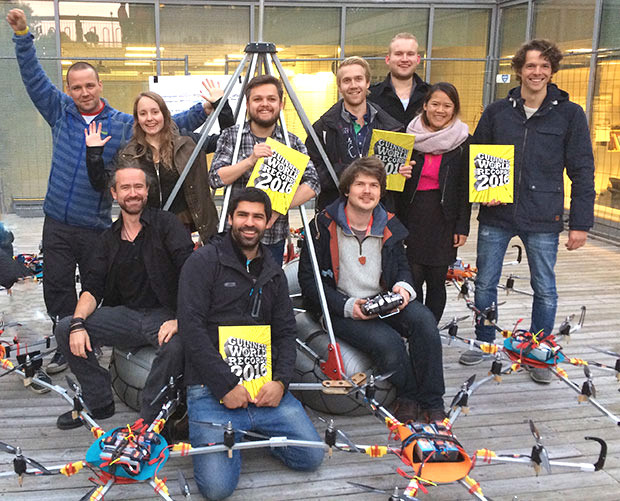Huge megacopter drone sets new Guinness World Record by lifting 61kg in Oslo

Students from the University of Oslo in Norway have set a new Guinness World Record for the heaviest payload ever lifted by a remote-controlled multicopter drone.
The record was set by the Megacopter, a huge multicopter drone that has 13 propellers and eight hexacopters powered by a total of 48 motors that reside on a frame built from aluminium and plywood. The drone, built by the University of Oslo's Department of Informatics, is designed with the intention of eventually carrying a single human being, which would make it a personal flight vehicle.
The unmanned aerial vehicle (UAV) took 18 months to build and was piloted by Henning Pedersen and Dan Richard Isdahl Eng, who set the new record by lifting a payload of 61kg (134lb 7.6oz) into the air and holding it for 37 seconds. According to the Guinness World Records, in order for the drone to fulfil the requirements of the challenge by lifting the payload, the lowest part of the payload had to be elevated to a height of over 1m for a minimum period of 30 seconds.
The record was actually set in October 2015, but it takes several months for the Guinness World Records to validate the claim. Including batteries, the Megacopter weighs a total of 76.6kg, which means it can lift a maximum payload of 73kg in order to stay within the European Aviation Safety Agency's drone regulations pertaining to unmanned aircraft that weigh 150kg.
According to hobbyist model aircraft magazine Norges Luftsportforbund, the world record attempt was fraught with problems, and during the attempt, the UAV was unable to lift the initial payload of 73kg, and then one of the battery eliminator circuit (BEC) controllers in one of the hexacopters short-circuited, which caused one of the engines to stop working.
In order to set the world record, the team from University of Oslo just needed to lift a minimum weight of 60kg, so the team took away 12kg of weight from the 73kg payload, to bring it down to 61kg, while a replacement hexacopter was installed on the drone.

The problems caused long delays, and the University of Oslo had only been granted permission to attempt the drone flight during daylight, but just minutes away from sunset, the team were able to get the UAV to lift the payload into the air and stay airborne long enough to set the record.
Interestingly, the Megacopter drone is officially registered to be able to lift a maximum payload of 149.9kg (including the weight of the aircraft), which means that it could potentially set an even greater record in the future and be able to lift 74kg in weight, and perhaps one day even make its dream come true of carrying humans.
"We used 24 Gens Ace LiPo batteries with six cells (22.2 volts) and 5000 mAh capacity. Pretty common RC batteries. It only flies for three to six minutes but we could double the number of batteries if we wanted, adding about 20 kg to the 76kg weight of the vehicle," Pedersen told IBTimes UK.
There are several organisations around the world currently trying to build personal flight vehicles. First, there's Flike, a personal flight vehicle designed by the Hungarian government's research institute Bay Zoltan Nonprofit. Flike is a tricopter that can carry a total weight – including payload – of 240kg. In April, Flike completed a successful manned test flight where it was able to hover and manoeuvre in the air while compensating for the wind, for one and a half minutes.
There's also the Hoverbike by UK firm Malloy Aeronautics; the Quadro UAS personal flight vehicle built by Dutch UAV engineer Thorstin Crijns which carries which carries 110kg of weight (including a 59kg payload); and the Snowstorm multicopter drone built by students from the National University of Singapore (NUS), which can carry a payload of 70kg and can stay in the air for five minutes.
© Copyright IBTimes 2025. All rights reserved.





















